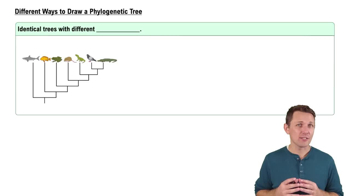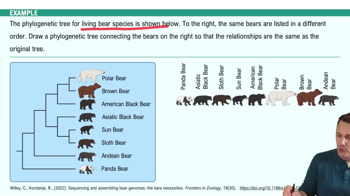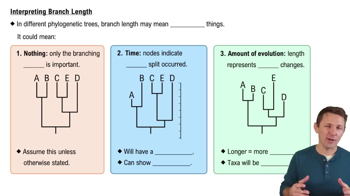Table of contents
- 1. Introduction to Biology2h 40m
- 2. Chemistry3h 40m
- 3. Water1h 26m
- 4. Biomolecules2h 23m
- 5. Cell Components2h 26m
- 6. The Membrane2h 31m
- 7. Energy and Metabolism2h 0m
- 8. Respiration2h 40m
- 9. Photosynthesis2h 49m
- 10. Cell Signaling59m
- 11. Cell Division2h 47m
- 12. Meiosis2h 0m
- 13. Mendelian Genetics4h 41m
- Introduction to Mendel's Experiments7m
- Genotype vs. Phenotype17m
- Punnett Squares13m
- Mendel's Experiments26m
- Mendel's Laws18m
- Monohybrid Crosses16m
- Test Crosses14m
- Dihybrid Crosses20m
- Punnett Square Probability26m
- Incomplete Dominance vs. Codominance20m
- Epistasis7m
- Non-Mendelian Genetics12m
- Pedigrees6m
- Autosomal Inheritance21m
- Sex-Linked Inheritance43m
- X-Inactivation9m
- 14. DNA Synthesis2h 27m
- 15. Gene Expression3h 20m
- 16. Regulation of Expression3h 31m
- Introduction to Regulation of Gene Expression13m
- Prokaryotic Gene Regulation via Operons27m
- The Lac Operon21m
- Glucose's Impact on Lac Operon25m
- The Trp Operon20m
- Review of the Lac Operon & Trp Operon11m
- Introduction to Eukaryotic Gene Regulation9m
- Eukaryotic Chromatin Modifications16m
- Eukaryotic Transcriptional Control22m
- Eukaryotic Post-Transcriptional Regulation28m
- Eukaryotic Post-Translational Regulation13m
- 17. Viruses37m
- 18. Biotechnology2h 58m
- 19. Genomics17m
- 20. Development1h 5m
- 21. Evolution3h 1m
- 22. Evolution of Populations3h 52m
- 23. Speciation1h 37m
- 24. History of Life on Earth2h 6m
- 25. Phylogeny2h 31m
- 26. Prokaryotes4h 59m
- 27. Protists1h 12m
- 28. Plants1h 22m
- 29. Fungi36m
- 30. Overview of Animals34m
- 31. Invertebrates1h 2m
- 32. Vertebrates50m
- 33. Plant Anatomy1h 3m
- 34. Vascular Plant Transport2m
- 35. Soil37m
- 36. Plant Reproduction47m
- 37. Plant Sensation and Response1h 9m
- 38. Animal Form and Function1h 19m
- 39. Digestive System10m
- 40. Circulatory System1h 57m
- 41. Immune System1h 12m
- 42. Osmoregulation and Excretion50m
- 43. Endocrine System4m
- 44. Animal Reproduction2m
- 45. Nervous System55m
- 46. Sensory Systems46m
- 47. Muscle Systems23m
- 48. Ecology3h 11m
- Introduction to Ecology20m
- Biogeography14m
- Earth's Climate Patterns50m
- Introduction to Terrestrial Biomes10m
- Terrestrial Biomes: Near Equator13m
- Terrestrial Biomes: Temperate Regions10m
- Terrestrial Biomes: Northern Regions15m
- Introduction to Aquatic Biomes27m
- Freshwater Aquatic Biomes14m
- Marine Aquatic Biomes13m
- 49. Animal Behavior28m
- 50. Population Ecology3h 41m
- Introduction to Population Ecology28m
- Population Sampling Methods23m
- Life History12m
- Population Demography17m
- Factors Limiting Population Growth14m
- Introduction to Population Growth Models22m
- Linear Population Growth6m
- Exponential Population Growth29m
- Logistic Population Growth32m
- r/K Selection10m
- The Human Population22m
- 51. Community Ecology2h 46m
- Introduction to Community Ecology2m
- Introduction to Community Interactions9m
- Community Interactions: Competition (-/-)38m
- Community Interactions: Exploitation (+/-)23m
- Community Interactions: Mutualism (+/+) & Commensalism (+/0)9m
- Community Structure35m
- Community Dynamics26m
- Geographic Impact on Communities21m
- 52. Ecosystems2h 36m
- 53. Conservation Biology24m
25. Phylogeny
Phylogeny
Problem 4a
Textbook Question
Textbook QuestionThree living species X, Y, and Z share a common ancestor T, as do extinct species U and V. A grouping that consists of species T, X, Y, and Z (but not U or V) makes up a. a monophyletic taxon. b. an ingroup, with species U as the outgroup. c. a paraphyletic group. d. a polyphyletic group.
 Verified step by step guidance
Verified step by step guidance1
Identify the characteristics of the group consisting of species T, X, Y, and Z. Since they all share a common ancestor T and include all descendants of T in the group, we need to determine the type of taxonomic group they form.
Understand the definitions of different taxonomic groups: Monophyletic groups consist of an ancestor and all of its descendants. Paraphyletic groups consist of an ancestor and some, but not all, of its descendants. Polyphyletic groups consist of various organisms that do not share an immediate common ancestor.
Analyze the group T, X, Y, and Z in relation to U and V. Since U and V are also descendants of T but are not included in the group, this suggests that the group might be missing some descendants of the common ancestor T.
Compare the characteristics of the group with the definitions: The group T, X, Y, and Z does not include all descendants of T (missing U and V), which rules out it being a monophyletic group.
Conclude that the group consisting of T, X, Y, and Z, which excludes U and V, forms a paraphyletic group, as it includes the common ancestor and some, but not all, of its descendants.
Recommended similar problem, with video answer:
 Verified Solution
Verified SolutionThis video solution was recommended by our tutors as helpful for the problem above
Video duration:
57sPlay a video:
Was this helpful?
Key Concepts
Here are the essential concepts you must grasp in order to answer the question correctly.
Monophyletic Taxon
A monophyletic taxon includes an ancestor and all of its descendants, forming a complete branch on the tree of life. This concept is crucial for understanding evolutionary relationships, as it reflects a true lineage. In the context of the question, the grouping of species T, X, Y, and Z represents a monophyletic group because it includes the common ancestor T and all its descendants.
Recommended video:
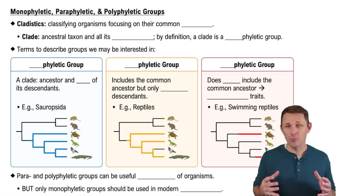
Monophyletic, Paraphyletic, & Polyphyletic Group
Ingroup and Outgroup
In phylogenetics, the ingroup refers to the group of species being studied, while the outgroup is a related species or group that helps to establish the evolutionary relationships. In this question, species X, Y, and Z form the ingroup, and species U serves as the outgroup, providing a reference point for understanding the characteristics and evolutionary history of the ingroup.
Recommended video:
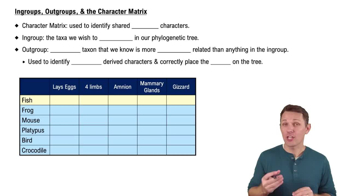
Ingroups, Outgroups, & the Character Matrix
Paraphyletic and Polyphyletic Groups
A paraphyletic group consists of an ancestor and some, but not all, of its descendants, while a polyphyletic group includes species that do not share a recent common ancestor. Understanding these definitions is essential for classifying species accurately. In the question, the grouping of T, X, Y, and Z is not paraphyletic or polyphyletic, as it includes all descendants of T.
Recommended video:

Monophyletic, Paraphyletic, & Polyphyletic Group

 7:10m
7:10mWatch next
Master Reading a Phylogenetic Tree with a bite sized video explanation from Bruce Bryan
Start learningRelated Videos
Related Practice









